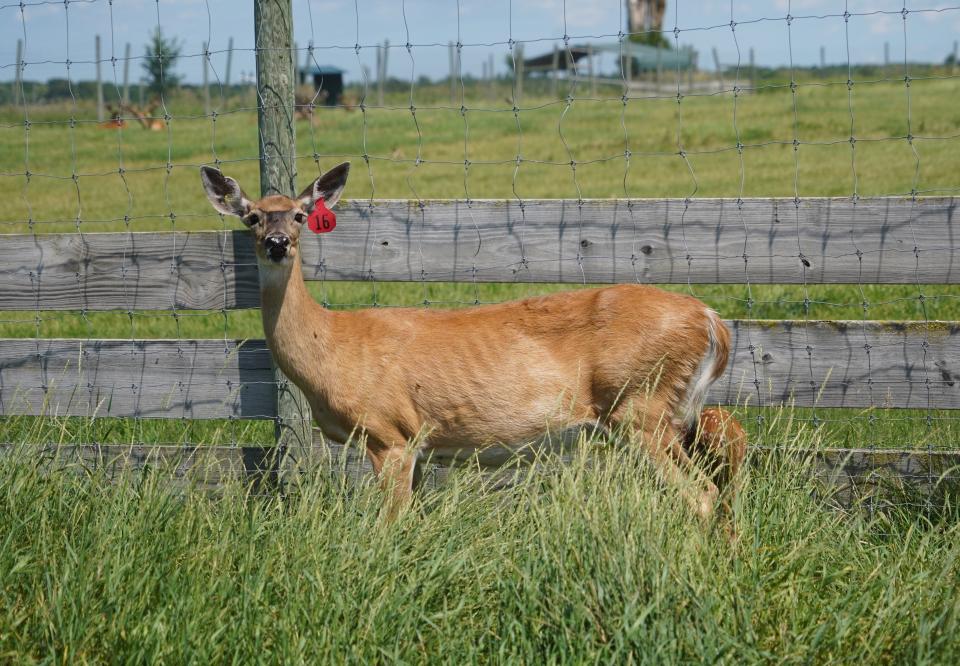Chronic wasting disease found at Washburn County shooting preserve

A captive white-tailed deer at a Washburn County shooting preserve has tested positive for chronic wasting disease, according to the Department of Agriculture, Trade and Consumer Protection.
The 3-year-old doe was at Thundeer Trophy Whitetails in Birchwood. As a result of the disease finding, the facility has been placed under quarantine.
The positive CWD result was confirmed by testing at the National Veterinary Services Laboratories in Ames, Iowa, and announced Thursday by DATCP.
Thundeer Trophy Whitetails has about 300 deer on 150 acres, according to DATCP.
Records show the CWD-positive doe was transferred Oct. 4, 2022, from Rodenkirch Whitetails and Genetics in Beaver Dam to Thundeer's farm in Washburn County.
At the time, CWD hadn't been found at either facility. However, in May DATCP announced a 9-year-old doe was found with the disease at Rodenkirch's deer farm.
As a result the 3-year-old doe was culled at Thundeer Trophy Whitetails for CWD testing. State agriculture officials did not say when the deer was killed or detail how much time passed since its arrival in Washburn County.
An epidemiological investigation has commenced at the Birchwood facility, according to DATCP.
The DATCP regulates deer farms for registration, record keeping, disease testing, permits and animal movement.
CWD is an always fatal, neurological disease of deer, elk and moose caused by an infectious protein called a prion. The disease was first recognized in the 1960s at a research facility in Colorado. It was first detected in 2002 in Wisconsin wild and captive deer.
Where found, CWD typically increases in prevalence and spreads in area. As of this year, it had been documented in 31 states, four provinces of Canada and several other foreign countries, according to the National Wildlife Health Center of the U.S. Geological Survey.
Although CWD has not been shown to cause human illness, the Centers for Disease Control and other health experts recommend humans not consume meat from a CWD-positive animal.
The finding at Thundeer Trophy Whitetails is the first CWD-positive deer in Washburn County since a listless, free-ranging doe was found near Shell Lake in 2011. The animal was euthanized and tested positive for the disease.
In the following 11 years, 2,698 wild deer were tested in the county; all were "CWD not detected."
As the disease becomes more prevalent in more of the state, northwestern Wisconsin stands out as the least CWD-affected region. No positive test of a captive or wild deer has been documented in Ashland, Bayfield, Douglas, Iron or Sawyer counties.
The finding at the Washburn County shooting preserve and the CWD-positive doe's history also highlights the risks associated with transporting deer. Wisconsin has 301 deer farms or shooting preserves, according to DATCP records.
Forty-one captive deer facilities have had animals test positive for CWD since 2001; 22 have been depopulated due to the disease, according to DATCP.
DATCP lists eight CWD-positive deer farms still in operation, as well as 12 CWD-positive shooting preserves still in operation.
Wisconsin lawmakers have not moved to restrict the deer farming industry.
But this year in Minnesota lawmakers banned any new deer farms and added several restrictions for existing deer and elk farms, including transferring regulation of deer farms from the state's agriculture department to its Department of Natural Resources.
The CWD finding at Thundeer Trophy Whitetails is expected to trigger a baiting and feeding ban in at least Washburn County. The Wisconsin DNR is expected to make an announcement in the coming days about any baiting and feeding rule changes.
This article originally appeared on Milwaukee Journal Sentinel: Chronic wasting disease found at Washburn County shooting preserve

